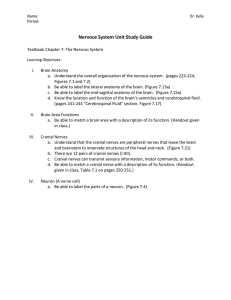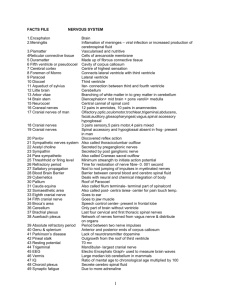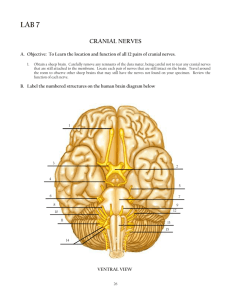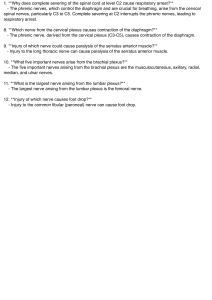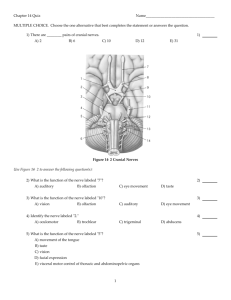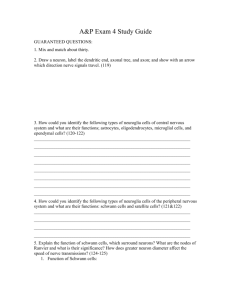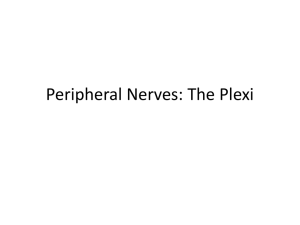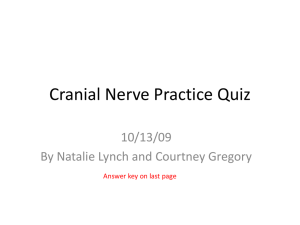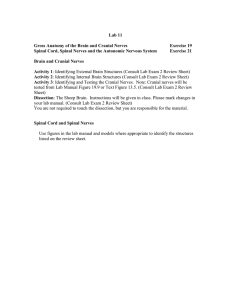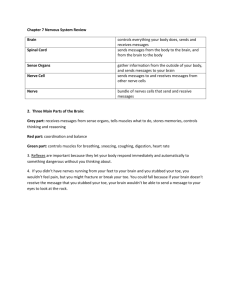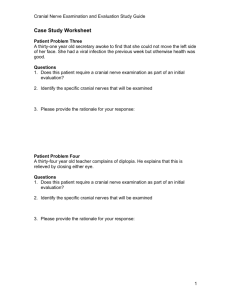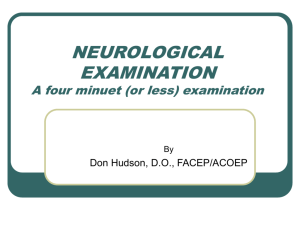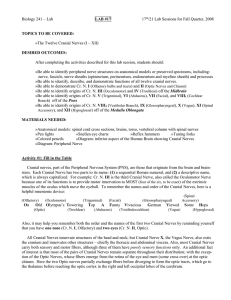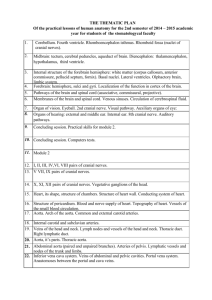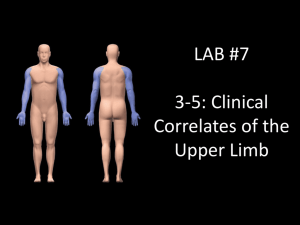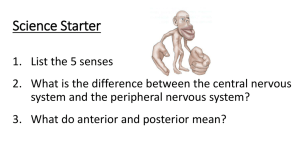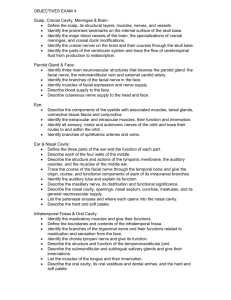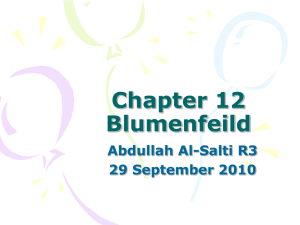Practice Quiz#3 - North Central State College
advertisement
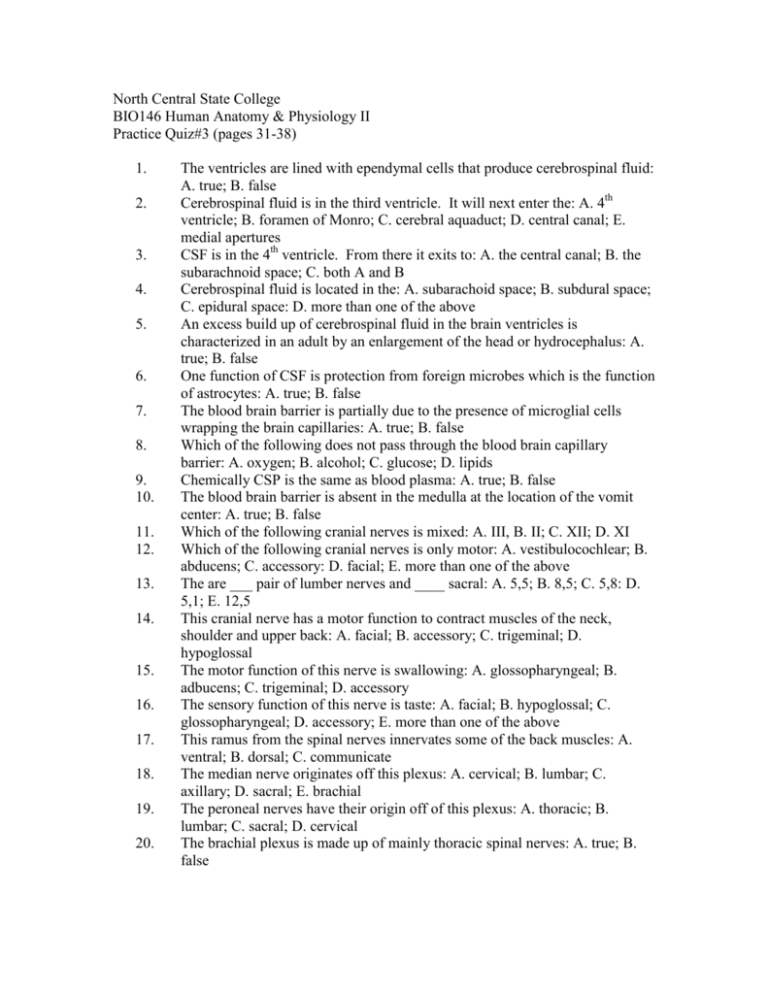
North Central State College BIO146 Human Anatomy & Physiology II Practice Quiz#3 (pages 31-38) 1. 2. 3. 4. 5. 6. 7. 8. 9. 10. 11. 12. 13. 14. 15. 16. 17. 18. 19. 20. The ventricles are lined with ependymal cells that produce cerebrospinal fluid: A. true; B. false Cerebrospinal fluid is in the third ventricle. It will next enter the: A. 4th ventricle; B. foramen of Monro; C. cerebral aquaduct; D. central canal; E. medial apertures CSF is in the 4th ventricle. From there it exits to: A. the central canal; B. the subarachnoid space; C. both A and B Cerebrospinal fluid is located in the: A. subarachoid space; B. subdural space; C. epidural space: D. more than one of the above An excess build up of cerebrospinal fluid in the brain ventricles is characterized in an adult by an enlargement of the head or hydrocephalus: A. true; B. false One function of CSF is protection from foreign microbes which is the function of astrocytes: A. true; B. false The blood brain barrier is partially due to the presence of microglial cells wrapping the brain capillaries: A. true; B. false Which of the following does not pass through the blood brain capillary barrier: A. oxygen; B. alcohol; C. glucose; D. lipids Chemically CSP is the same as blood plasma: A. true; B. false The blood brain barrier is absent in the medulla at the location of the vomit center: A. true; B. false Which of the following cranial nerves is mixed: A. III, B. II; C. XII; D. XI Which of the following cranial nerves is only motor: A. vestibulocochlear; B. abducens; C. accessory: D. facial; E. more than one of the above The are ___ pair of lumber nerves and ____ sacral: A. 5,5; B. 8,5; C. 5,8: D. 5,1; E. 12,5 This cranial nerve has a motor function to contract muscles of the neck, shoulder and upper back: A. facial; B. accessory; C. trigeminal; D. hypoglossal The motor function of this nerve is swallowing: A. glossopharyngeal; B. adbucens; C. trigeminal; D. accessory The sensory function of this nerve is taste: A. facial; B. hypoglossal; C. glossopharyngeal; D. accessory; E. more than one of the above This ramus from the spinal nerves innervates some of the back muscles: A. ventral; B. dorsal; C. communicate The median nerve originates off this plexus: A. cervical; B. lumbar; C. axillary; D. sacral; E. brachial The peroneal nerves have their origin off of this plexus: A. thoracic; B. lumbar; C. sacral; D. cervical The brachial plexus is made up of mainly thoracic spinal nerves: A. true; B. false 21. This nerve innervates the adductors of the leg: A. femoral; B. sciatic; C. tibial; D. obturator For each of the following select A if it is characteristic of both the sympathetic and parasympathetic, select B if it is a characteristic of the sympathetic only, select C if it is a characteristic the parasympathetic only, select D if it is not a characteristic of the autonomic nervous system. 22. 23. 24. 25. 26. 27. 28. 29. 30. 31. 32. 33. 34. 35. 36. 37. 38. 39. 40. has smooth muscle as an effector has skeletal muscle as an effector related to rest and digest involves cranial nerves involves lumbar nerves involves terminal ganglia longer postsynaptic neurons presynaptic nerve fiber releases acetylcholine postsynaptic nerve fiber releases norepinephrine stimulates the adrenal medulla gland to secrete has only cholinergic fibers dilates blood vessels in skeletal muscles promotes gastric juice secretion inhibits urine formation dilates eye pupils involved in vaginal penetration by the penis (because of an erection) and fertilization (because of ejaculation of semen) of an egg decrease in saliva production two neurons from the CNS to the effector normally includes large myelinated nerve fibers 1b,2c,3c,4a,5b,6b,l7b,l8d,9b,10a,11c,12e,13a,14b,15a,16e,17b,18e,19c,20b,21d,22a,23d, 24c,25c,26b,27c,28b,29a,30b,31b,32c,33b,34c,35b,36b,37a,38b,39a,40d
